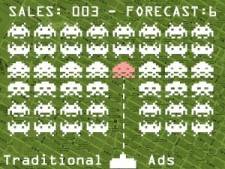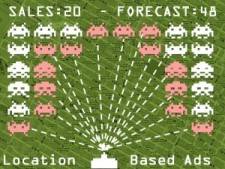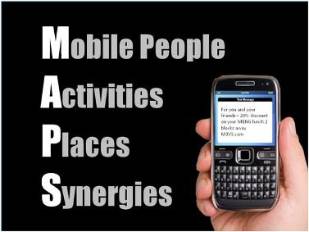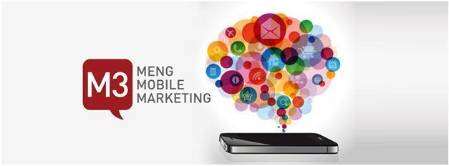Why mobile?
If we look at the raw numbers, there are around 1.3 billion phone lines in the world. The number of TV sets and personal computers is higher, around 1.5 billion of each. On the other hand, according to “The world in Figures” published by the ITU and ICT, by the end of 2010 there will be an estimated 5.3 billion mobile cellular subscriptions worldwide. Cellular coverage is reaching about 90% of the world population and 80% of the population living in rural areas.
Look around you during the day — on a bus, at a restaurant, walking on the street, or sitting in your office — and try to answer this question: If I want to reach that person with a marketing message, right now, what media channel should I use? How many of those are carrying a yellow pages book? How many have a newspaper? Do you use a telemarketer, a TV ad, direct mail, or a notice to her phone?
According to the CMO Council, SMS is typically read within an average of 15 minutes after receipt and responded to within 60 minutes. Moreover, no other media has that rate of response. The average SMS response rate typically ranges between 15% to 30%, compared to 5% for email and 2.6% for direct mail. Response rates are even higher when the text messages are geo-referenced.

Your Target Market is constantly moving and a change in location will changeeverything (including moving from one room to another). You can add 
When leaving their houses in the morning, most people will take 3 basic things: keys, wallet, and their cellular phone. If you forgot your wallet or your mobile phone, how long it will take you to notice that they are missing? Most probably you will arrive at your office without a wallet, but never without your mobile phone. We are perpetually connected. Mobile phones became an extension of us. They reflect people’s identity; they are personalized with ring tones, answer tones, and cases. Or as Google CEO Eric Schmidt said in his 2010 Mobile World Congress keynote address, “…The basic message is pretty simple… your phone is your alter ego, an extension of everything we do.” His conclusion is a clear message to us as a marketing community, “…the new rule is ‘mobile first’ in everything…Our job is to make mobile be the answer to everything.”
Do I imply that mobile marketing will replace the marketing practice as we know it today? Not at all. But Mobile is becoming an important part of the marketing mix and an essential ingredient on the success of good marketing campaigns.
Why geographical information?
At this point it is necessary to emphasize that we are talking not only about advertising. Mobile marketing is broader and includes not only delivering ads or coupons to the customer but also other activities like collecting information that will feed your strategic marketing decisions. As a marketer, you may need to answer these questions:
- Where do my customers live, and where do they buy?
- Where are my competitors?
- Where are my marketing efforts invested?
- Where are my opportunities? Where should I put my next point of sale?
- Where are my sales representatives?
- To what advertising medium do my customers respond? Billboards? Mobile coupons? Where were they when exposed to my campaign?
- Are products sold better in particular zones? Where and why?
“Where” is present in every aspect of your business. It is an inherent question in your mobile marketing strategy, and location-based information is a key component of your solution.
MAPS – a new definition for a very old term
In October 2007 Nokia announced the agreement to acquire Navteq, one of the two largest providers of digital map information, for roughly $8.1 billion. Nokia’s President and Chief Executive at that time, Olli-Pekka Kallasvuo, said that “By joining forces with Navteq, we will be able to bring context and geographical information to a number of our Internet services…Nokia’s unique vision for location based services aligns perfectly with Navteq’s vision to enable everyone to find their way to people, places and opportunities on mobile communications devices, cars, desktop computers and in all the other places that are important to them.”
Financial deals making aside, why are maps so important to create business acquisitions for more than 80% of Facebook value at that time? Is the quest for people, places and opportunities something new? Is putting intelligence in a map something we just start using in the last years?
Well, as a matter of fact we can find this type of data gathering in very old scriptures. Reading Numbers 13:2, youcan find that Moses was ordered to map the land – “Send out for yourself men who will scout the Land of Canaan…”. In Numbers 13:18-20, you can read that he actually sent his surveyors, to gather information about PEOPLE who inhabit the land; if they were strong or weak; and if they were in few or many PLACES and what kind of land was it, good or bad, camps or fortresses? They also gathered information on OPPORTUNITIES: what is the soil like — fat or lean — are there any trees on it or not, and what type of fruits grew there.
What has changed since then? Technology!

Ending with a beginning
Foursquare, Location Based Text messages, Geogames, tweets on maps, mobile apps, geo ads, and many other tools are available. Where do you start? As in any other marketing effort you start by defining the strategy regardless of the tools you are pushed to use. Your marketing strategy will determine the tools (not the other way around). Then, find the craftsmen that master those tools and incorporate them to your team.
And that’s why I end with a beginning. M3VS mobile marketing virtual conference (April 18), organized by MENG, is an excellent opportunity to get started and learn from others.
One last thought: remember that as much as mastering the usage of MS Word doesn’t make one a poet, knowing how to claim a business in foursquare doesn’t necessarily make one a Location-Based / Mobile Marketing expert. The emphasis is always on Marketing.

